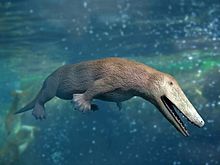Ambulocetus
| Ambulocetus | ||||||||||||
|---|---|---|---|---|---|---|---|---|---|---|---|---|

Skeletal reconstruction of Ambulocetus , in the background below Pakicetus |
||||||||||||
| Temporal occurrence | ||||||||||||
| Ypresium , Lower Eocene | ||||||||||||
| estimated approx. 49 to approx. 50 million years | ||||||||||||
| Locations | ||||||||||||
| Systematics | ||||||||||||
|
||||||||||||
| Scientific name | ||||||||||||
| Ambulocetus | ||||||||||||
| Thewissen , Hussain , & Arif , 1994 | ||||||||||||
| Art | ||||||||||||
Ambulocetus ("walking whale") is a genus of early whales (Cetacea) that lived during the early Eocene period (about 50 to 49 million years ago). Only the type A. natans is known.
Way of life
For a long time it was assumed that Ambulocetus, as a primitive whale, had the ability to swim on land in addition to its ability to swim. Functional morphological studies by Ando and Fujiwara (2016) were able to show that the animal's chest was too weak to compensate for the forces exerted when walking. Thus Ambulocetus no longer had the prerequisites for terrestrial locomotion and had already switched to the fully aquatic way of life of today's whales.
The animal, the remains of which were discovered in Asia , is considered to be a transitional form that clearly shows that whales evolved from small, land-living mammals . The three-meter-long ambulocetus had some anatomical similarities with today's crocodiles , which is an indication of an amphibious way of life. His hind limbs were also more suitable for locomotion in water than on land. Ambulocetus was probably already moving in the water with vertical, undulating movements ( undulation ), like modern whales. It has been speculated that it hunted like crocodiles , lurking in shallow water to catch inattentive prey. Chemical analyzes of its teeth showed that Ambulocetus lived in both salt and fresh water.
Ambulocetus had no auricles . To track down prey, he might lay his head on the ground and use his lower jaw to feel the vibrations that potential prey was causing.
Systematics
Scientists believe Ambulocetus to be a primitive whale as there is evidence of an adaptation to life underwater: anatomical features of its nose prevented it from swallowing water and its ears had much in common with modern whales, which enabled it to do well underwater to listen. These points are clear indications that Ambulocetus was indeed an early whale.
The vertebrate paleontologist Hans Thewissen discovered the holotype of Ambulocetus in Pakistan . It was first described in 1995. At the time of the Eocene , the find area was a coastal region bordering the primeval sea of Tethys .
literature
- JGM Thewissen, SI Madar, ST Hussain: Ambulocetus natans, an Eocene cetacean (Mammalia) from Pakistan . Senckenbergische Naturforschende Gesellschaft, Frankfurt am Main 1996, ISBN 3-929907-32-1 , p. 1-86 ( Courier Research Institute Senckenberg 191).
- SI Madar, JGM Thewissen, ST Hussain: Additional holotype remains of Ambulocetus natans (Cetacea, Ambulocetidae), and their implications for locomotion in early whales . In: Journal of Vertebrate Paleontology . tape 22 , no. 2 , July 2002, ISSN 0272-4634 , p. 405-422 ( abstract ).
Web links
- Ambulocetus. BBC , accessed April 18, 2015 .
Individual evidence
- ↑ Konami Ando, Shin-ichi Fujiwara: Farewell to life on land - thoracic strength as a new indicator to determine paleoecology in secondary aquatic mammals. (PDF) In: Journal of Anatomy , 2016.
